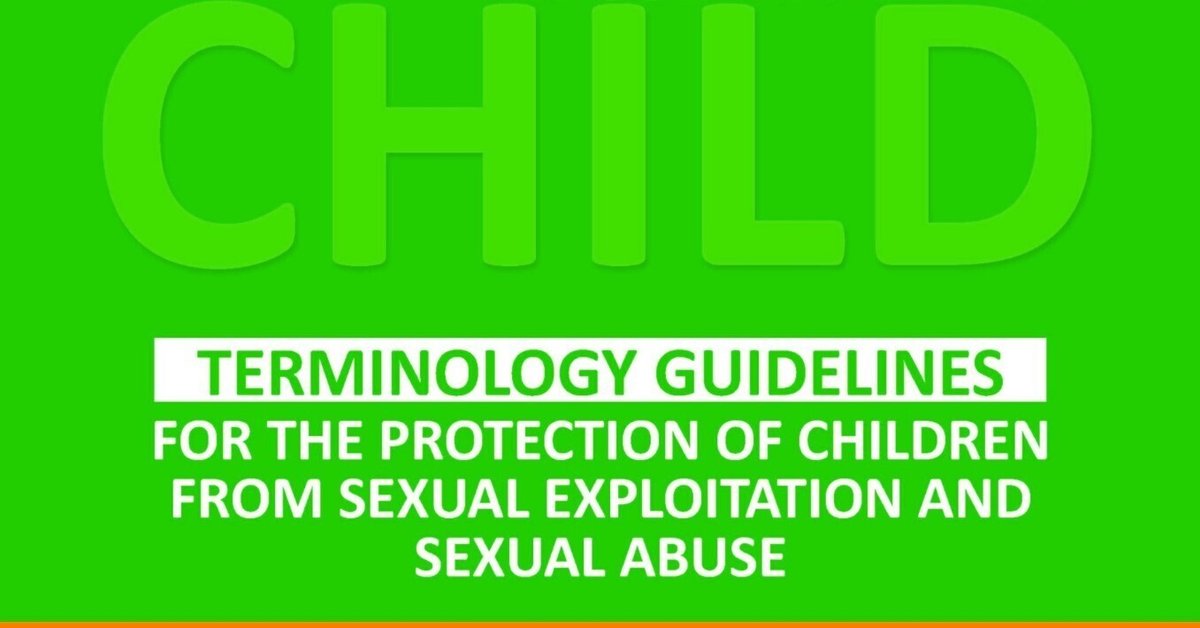
【抄訳】『子どもを性的搾取と性的虐待から守るための用語ガイドライン』Ⅲ~「デジタル生成児童性虐待表現物」編~|IWG (2016.01.28)
※以下は2016年9月にTumblrに掲載した記事を改修して転記したものです。
はじめに
2016年1月末、国際刑事警察機構(ICPO)を含む18の国際機関が参画したIWG※1が発表した所謂「ルクセンブルク・ガイドライン※2」と言われる『児童を性的虐待及び性的搾取から保護するための用語ガイドライン』(TERMINOLOGY GUIDELINES FOR THE PROTECTION OF CHILDREN FROM SEXUAL EXPLOITATION AND SEXUAL ABUSE) 。「児童ポルノ」(child pornography)と 「児童性虐待表現物・児童性搾取表現物」(CSAM/CSEM)に関する議論を扱った同書のF章1-4i(pp.35-40)までは抄訳を完了したが、日本で重要な関心事となっている所謂「非実在児童」(non-existent child)を扱う以後の項目、F章4ii以降(pp.41-43)も重要と捉え、幸い短いセクションなので作業することにした。以下は、F.4.ii『 Computer/digitally generated child sexual abuse material』(コンピュータ・デジタル生成による児童性虐待表現物)の抄訳である。
本編
F.4.ii コンピュータ・デジタル生成による児童性虐待表現物
F.4.ii Computer/digitally generated child sexual abuse material
△この用語の用法については、特段の注意を要する。
Computer-generated child sexual abuse material (コンピュータ生成による児童性虐待表現物) とは、デジタル媒体を介した児童虐待表現物及びその他全体叉は一部が人工的又はデジタル的に作成された児童の性対象化された影像を制作することをいう。こうして作成された影像の写実性は、実際にはそうではなくても、あたかも児童が現実に関与しているかのような幻像を創り出す。この種類の表現物は、一般に“virtual child pornography (仮想児童ポルノ)’ [脚注176: S. Liu, “Ashcroft virtual child pornography and first amendment jurisprudence (アシュクロフト、仮想児童ポルノと、修正第一条の法理) ”, UC Davis Journal of Juvenile Law and Policy (カリフォルニア大学デイビス校少年法・政策ジャーナル), vol. 11, no. 1, 2011, pp.1-54. 著者は“virtual child pornography (仮想児童ポルノ)” について、(1) wholly computer-generated “child pornography” (完全CGにより生成された児童ポルノ)、(2) morphed “child pornography”(モーフィング児童ポルノ)、(3) “child pornography” made by using youthful-looking adults (幼く見える成人を利用して製造された児童ポルノ)という3つのカテゴリに分類している。]、又は “pseudo child pornography (疑似児童ポルノ)”と呼ばれる。
Computer-generated child sexual abuse material is the production, through digital media, of child sexual abuse material and other wholly or partly artificially or digitally created sexualised images of children. The realism of such images creates the illusion that children are actually involved, although this is not the case. This type of material is also commonly referred to as “virtual child pornography’ [176 S. Liu, “Ashcroft virtual child pornography and first amendment jurisprudence”, UC Davis Journal of Juvenile Law and Policy, vol. 11, no. 1, 2011, pp.1-54. The author refers to three categories of “virtual child pornography”: wholly computer-generated “child pornography”, morphed “child pornography”, and “child pornography” made by using youthful-looking adults.] or “pseudo child pornography”.
このような表現物はブダペスト条約 [サイバー犯罪に関する条約]の第9条(2)c、及びEU指令2011/93 [児童の性的虐待及び性的搾取並びに児童ポルノの対策に関する指令2011/93/EU]の第2条2c(iv)にも網羅され、当該条文には、“realistic images of a child engaged in sexually explicit conduct (あからさまに性的な行為を行う児童の写実的影像)“ と記述されている。国レベルでは、"virtual child pornography (仮想児童ポルノ)” や “pseudo child pornography (疑似児童ポルノ)” を “child pornography (児童ポルノ)” 犯罪として処罰対象とすべきか否かについて一部議論がある [脚注177: 例えば、合衆国連邦最高裁裁判アシュクロフト司法長官対Free Speech Coalition (言論の自由連合) における第九控訴裁判所への上告書第00-795号(控訴:2001年10月30日控訴、結審:2002年4月16日)では、裁判所側はCPPA (Child Pornography Prevention Act: 1996年児童ポルノ禁止法)卑猥でも実在児童を性的搾取した結果製造されたものでもない記録物が禁止対象に含まれていることから「広範すぎる」として真っ向から無効と否定した。判決要旨は https://supreme.justia.com/cases/federal/us/535/234/ で入手可能。一方、英国では、"pseudo child pornography (疑似児童ポルノ)“ は ‘child sexual abuse material (児童性虐待表現物)’ と全く同一扱いで、実在児童を描写しているのと同じに扱われる。但し、犯罪の量刑は「疑似児童ポルノ」の場合は比較的に軽く設定されている。]
This type of material is covered by the Budapest Convention (Article 9(2)©) and EU Directive 2011/93 (Article 2©(iv)) and referred to by these legal instruments as “realistic images of a child engaged in sexually explicit conduct”. At national level, there is some debate as to whether or not “virtual child pornography” and “pseudo child pornography” should be included in offences related to “child pornography”.[177 See, for instance, US Supreme Court, Ashcroft, Attorney General, et al. vs. Free Speech Coalition et al., Certiorari to the US Court of Appeals for the Ninth Circuit, No. 00-795, argued 30 October 2001, decided 16 April 2002. In this case, the Ninth Circuit held the Child Pornography Prevention Act (1996) invalid on its face, finding it to be substantially overbroad because it bans materials that are neither obscene nor produced by the exploitation of real children. Summary available at https:// supreme. justia. com/ cases/ federal/ us/ 535/ 234/ . In the UK, on the other hand, pseudo child pornography is treated identically to child sexual abuse material depicting real children, except with regard to sentencing for the offence, which may be lighter in the case of pseudo child pornography.]
Computer-generated child sexual abuse material (コンピュータ生成による児童性虐待表現物) には、性的行為に従事するか、或いは性対象化した形態で児童を描写する疑似的な写真 (“pseudo photograph”)、コミック、図画、漫画等 [脚注178: 大人だけでなく子どもも対象にした日本のコミックスの形式でグラフィックノベル等も含まれる] のカトゥーン、及びアニメ [脚注179: 大人だけでなく子どもも対象にした日本の劇場及びテレビ用アニメーション] 等、並びに、児童性虐待を描写する実在児童の関与のない長編動画等が含まれるが、これらに限られない。「コンピュータ生成の(Computer-generated)」という修飾は付くものの、人工的に生成された児童性虐待表現物は、デジタル機器の支援を経て創造されているため、性的行為に従事する児童を手作業で描写した図画も児童性虐待表現物と捉えられる。
Computer-generated child sexual abuse material can include, but is not limited to, pseudo photographs, comics, drawings, and cartoons such as manga [178 A style of Japanese comic books and graphic novels, typically aimed at adults as well as children.] and anime,[179: A style of Japanese film and television animation, typically aimed at adults as well as children.] which depict children involved in sexual activities or in a sexualised manner, and full movies of child sexual abuse that do not involve real children. Despite the use of the prefix “computer-generated”, it is important to recall that, while most artificially created child sexual abuse material is indeed created with the help of a digital device, a hand-drawn picture depicting a child involved in sexual activities can also represent child sexual abuse material.
“Pseudo photograph” (疑似的な写真) とは、「コンピュータ・グラフィックにより生成されたかの如何によらず、写真であると見られる影像」 [脚注180: 1994年改正の1978年改正英国児童保護法第7条(7)による。] である。このような"morphed (モーフィング)“影像、若しくは "blended (ブレンド)"影像ともよばれる写真は、複数の写真或いは複数の写真の一部(主に子どもと大人のもの)を重ね合わせて一つの影像を生成することにより創り出される [脚注181: モーフィング ("morphed”) 影像とは、(コンピュータソフトウェア等の利用により)元の影像からそれとは異なるものへと改変されたものを指す。児童性虐待及び性搾取の文脈でいえば、児童の影像をわいせつな成人の影像と「ブレンド」して、児童が性的行為に従事しているかに見えるように創造すること等を指す。90年代に登場した “metamorphosis (メタモーフォシス=メタ変換=変態)” という元の物体が全く違うものへと変態 (transformation) するプロセスを表す言葉に由来する用語]。コンピュータ支援による写真加工技術が誕生する以前、犯罪者は裸の大人或いは他の子どもの写真に、幻想の対象である子どもの頭部を重ね合わせること等で行われてきた。
A “pseudo photograph” is “an image, whether made by computer-graphics or otherwise howsoever, which appears to be a photograph”.[180 UK Protection of Children Act, Article 7(7), 1978 (as amended in 1994).] Such photographs, which are also sometimes referred to as “morphed” or “blended” images, are created by digitally combining a number of photographs or portions of photographs (often of children and adults) to create an individual image.[181 A morphed image has been changed from what it was originally into something else (e.g. by use of computer software). In the context of child sexual exploitation and sexual abuse, an image of a child can be morphed by, for instance, blending it with a pornographic image of an adult, so it appears as if it is a child who is engaged in sexual activities. This is a term coined in the 1990s from the term “metamorphosis”, which signifies a process of transformation in which something changes completely into something different to what it was.] In the days before computer-aided photo editing was available, offenders would place the picture of the head of a child about whom they were fantasising onto that of the naked body of an adult or another child.
観察報告に拠れば、このような種類の表現物には、青少年に子どものようなポージングをさせ、記録又は撮影したものも含まれ、更に小道具を使って幼さを強調しているものもある。このような種類の表現物は、"pseudo-infantile pornography (疑似幼児ポルノ)“ 又は "initiation pornography (入門ポルノ)"と呼ばれる [脚注182: 児童売買、児童売春及び児童ポルノに関する国連特別報告者報告, パラ22. ※報告年月日の記載が無いが、調べた結果その内容から現特別抗告者のマウド・ブキッキオ氏による日本視察報告であると判明 http://www.ohchr.org/Documents/Issues/Children/SR/A_HRC_31_58_Add_1.doc ]。この問題を統一的に扱う国際法は存在しないものの、ブダペスト条約及びEU指令2011/93の両方において、"child pornography (児童ポルノ)” の定義として “persons appearing to be minors (未成年であると外見上認められる者)” と明示されている。[訳注: 但し、EU指令では"minor(未成年)"ではなく"child(児童)"と表記されている]
It has been observed that this type of material can also include the practice whereby young adults are recorded or photographed in child-like poses, staged with props to reinforce the impression of youth; this has been referred to as “pseudo-infantile pornography” or “initiation pornography”.[182 Report of the Special Rapporteur on the Sale of Children, Child Prostitution and Child Pornography, Paragraph 22.] While this is not uniformly addressed by international law, it is noteworthy that the Budapest Convention and EU Directive 2001/93 both explicitly include “persons appearing to be minors” in the definition of “child pornography”.
「コンピュータ生成児童性虐待表現物」の創造により児童に対する直接的な危害が発生する訳ではないが、それが (i) グルーミングにより児童の搾取に利用されることが確認されており、(ii) 極めて現実的な幻想を抱かせ性犯罪者の性癖を増長させて児童性虐待表現物の市場を維持することに寄与し、 (iii) 児童の性対象化を許容する文化を創り出しそれによって需要を喚起してしまうため、依然として有害性がある [脚注183 ECPAT International, “Protection and the OPSC: Justifying Good Practice Laws to Protect Children from Sexual Exploitation (OPSCと児童の保護: 児童を性搾取から保護するためのグッドプラクティス法)”, Journal Series No. 2, 2012 http://www.ecpat.net/sites/default/files/ecpat_journal_apr2012_final.pdf]。
Although computer-generated child sexual abuse material does not necessarily involve direct physical harm to a child in its creation, it is still harmful because (i) it is known to be used in grooming children for exploitation; (ii) it fuels very real fantasies, encourages the propensity of sexual predators, and contributes to maintaining a market for child sexual abuse material; and (iii) it creates a culture of tolerance for the sexualisation of children and thereby cultivates demand.[183 ECPAT International, “Protection and the OPSC: Justifying Good Practice Laws to Protect Children from Sexual Exploitation”, Journal Series No. 2, 2012 http://www.ecpat.net/sites/default/files/ecpat_journal_apr2012_final.pdf]
結論
Conclusion:
“Computer (or digitally) generated child sexual abuse material (コンピュータ(又はデジタル)生成児童性虐待表現物)” の用語には、児童が性的行為に関わっている、又は性対象化された仕方で関わっている(或いはその両方)あらゆる形態が網羅されている。特異なのは、当該表現物の制作に実在児童への実際の接触による虐待が含まれず、あくまで実在児童に見えるように人工的に創造されている点にある。これら表現物には、"virtual child pornography (仮想児童ポルノ)” と言われるものや “pseudo photographs (疑似的な写真)” も含まれる。
The term encompasses all forms of material representing children involved in sexual activities and/or in a sexualised manner, with the particularity that the production of the material does not involve actual contact abuse of real children but is artificially created to appear as if real children were depicted. It includes what is sometimes referred to as “virtual child pornography” as well as “pseudo photographs”.
人工的に創造された児童性虐待表現物はコンピュータ生成によるものである場合が多いが、当該表現物が、例えば手作業により制作された可能性を排除しないことが肝要である。コンピュータ生成児童性虐待表現物は、児童に有害な影響を及ぼす可能性を持ちつつも、万国において違法である訳ではない。
Although most artificially created child sexual abuse material is computer-generated, it is important not to exclude the possibility that such material can be, for instance, drawn by hand. Computer-generated child sexual abuse material is not illegal everywhere, although it can have a harmful effect on children.
この文脈で使用される"Virtual (仮想)“ の用語は、"existing online (オンライン上に存在) ” することと混同して解釈されてはらない。 なぜならばこの用語は、オンライン上には存在するが、児童を描写したという印象を持たせる目的を持って創造された影像を示すからである。児童を性対象化することそれ自体には、「仮想的」或いは「非実在」である側面は皆無であり、これらの用語を使用することは、そうした行為により児童に及ぶ害や、そうした表現物が性犯罪者又は潜在的な性犯罪者の認識を歪める効果の深刻さを矮小化するリスクを孕む。したがって、「コンピュータ生成児童性虐待表現物」等の用語は、この事象を表すのにより適した用語と言えるであろう。
The term “virtual” frequently used in this context should not be confused with “existing online”, because, although it does indeed exist online, it refers to images that have been created with the purpose of conveying the impression that they depict children. There is nothing “virtual” or unreal in the sexualisation of children, and these terms risk undermining the harm that children can suffer from these types of practices or the effect material such as this can have on the cognitive distortions of offenders or potential offenders. Therefore, terms such as “computer-generated child sexual abuse material” appear better suited to this phenomenon.
用語解説
※1「IWG」
IWG: Interagency Working Group on Sexual Exploitation of Children (児童の性的搾取に関する国際関係機関ワーキンググループ)とは、「子どもへの暴力」に関する国連事務総長特別代表、国連人権高等弁務官事務所 (OHCHR)、「子どもの人身売買、児童売春、児童ポルノ」に関する国連特別報告者等の個人、及び児童の権利に関する国連委員会、国連児童基金 (UNICEF)、国際労働機関 (ILO)等の国連の諸機関や関連機関、欧州評議会、ユーロポール、インターポール等の政府間機関、 米州子ども研究所 (IIN) 、 国際行方不明・被搾取児童センター (ICMEC) 等の研究機関、及びセーブ・ザ・チルドレン、PLANインターナショナル等の非政府機関 (NGO) 等18の団体と個人が参加する、関係諸機関の国際ワーキンググループ。タイに本部を置く非政府組織EPCATインターナショナルが主導して2014年9月に設立された。
※2「ルクセンブルク・ガイドライン」
『ルクセンブルク・ガイドライン』(The Luxembourg Guideline)とは、 IWGが2016年1月に発表した "Terminology Guidelines for the Protection of Children from Sexual Exploitation and Sexual Abuse (児童を性的搾取及び性的虐待から保護するための用語ガイドライン)。114ページに及ぶ包括的なガイドラインで、児童に関わる性的搾取行為や性的虐待行為に関して国際機関、政府機関や警察機関が使用するあらゆる表現・用語を網羅し、これらに対する「適切な用語」を提案する。日本でムーブメントとなった、法定用語としての「児童ポルノ」にかわる用語としての”child abuse material (児童虐待表現物 “ という言葉は、この議論から生まれた結果の一部だった。全体のどういったコンテクストでこの用語に落ち着いたのかについては、『ガイドライン』本編 (PDF) を参照(p.38~40)。
「IWG」参加団体・個人
African Committee of Experts on the Rights and Welfare of the Child (子どもの権利と福祉に関するアフリカ 委員会)
Child Rights Connect
Council of Europe Secretariat (欧州評議会事務局)
ECPAT International (アジア観光における児童買春根絶国際キャンペーン)
Europol (ECPO: 欧州刑事警察機構)
INHOPE - The International Association of Internet Hotlines (国際インターネットホットライン協会)
Instituto Interamericano del nino, la nina y adolescentes (OEA: 米州子ども研究所)
International Centre for Missing and Exploited Children (ICMEC: 行方不明・被搾取児童国際センター)
International Labour Office (ILO: 国際労働機関)
International Telecommunications Satelite Organisation (ITSO: 国際電気通信衛星機構)
INTERPOL (ICPO: 国際刑事警察機構)
Office of the United Nations High Commissioner for Human Rights (OHCHR: 国連人権高等弁務官事務所)
Plan International
Save the Children International
United Nations Committee on the Rights of the Child (児童の権利に関する国連委員会)
United Nations Special Rapporteur on the Sale of Children, Child Prostitution and Child Pornography(児童の人身売買・児童売春・児童ポルノに関する国連特別報告者)
United Nations Special Representative of the Secretary General on Violence against Children 子どもに対する暴力に関する国連事務総長特別代表
United Nations Children’s Fund (UNICEF: ユニセフ)
抄訳一覧
[F.1-3 児童ポルノ(p.35~38)](一括掲載)
F.1. 法的拘束力のある協定文書等における定義
F.2. 法的拘束力のない協定文書等
F.3. 用語に関する考慮事項
[F.4.i-iv 関連する用語(p.38~43)](個別掲載)
F.4.i 児童性虐待表現物/児童性搾取表現物
F.4.ii デジタル生成による児童性虐待表現物
F.4.iii 性対象化された児童の影像/ 児童エロチカ
F.4.iv 自己生成による性的コンテンツ/表現物
[その他、ICPOのプレスリリース、FAQ等]
いいなと思ったら応援しよう!

